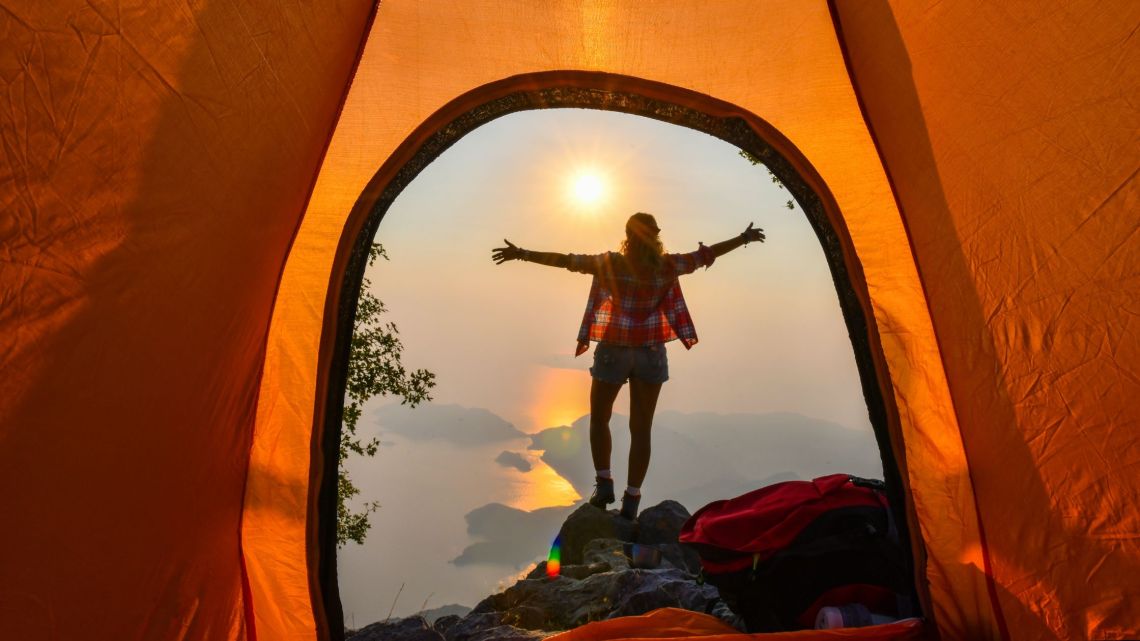
Beach Camping for Beginners: A Step-by-Step Guide to Your First Trip
Camping by the ocean is a truly magical experience that allows you to disconnect from the hustle and bustle of daily life while immersing yourself in the beauty of nature. The sound of crashing waves, the salty sea breeze, and the stunning sunsets are just a few reasons why beach camping is becoming increasingly popular.
Whether you are looking to relax on sandy shores or explore coastal trails, beach camping offers a unique opportunity to connect with both land and sea. From setting up your tent on soft sand to roasting marshmallows over a crackling campfire, every moment spent at the beach is filled with adventure and relaxation.
But if you are new to this and never have the experience of set up a camp in the beach, you must know what to do, what to take, how to set up a tent, what to cook and so on. This very article here will help you with beach camping for beginners and it will a guidance to your first ever trip.
Beach Camping for Beginners
Planning Your Trip
When planning your beach camping trip, one of the most important factors to consider is choosing the right beach. Look for a spot that offers a balance between beauty and convenience, with easy access to amenities like bathrooms and showers.
Consider how easily accessible the beach is from your location. Is it within driving distance, and are there paved roads leading to the campground? Look for beaches that offer amenities suited to your needs. Some campgrounds provide facilities such as restrooms, showers, potable water, and picnic areas, while others may be more primitive.
Think about the activities you want to engage in during your beach camping trip. Are you interested in swimming, surfing, fishing, hiking, or wildlife viewing? Choose a beach that offers opportunities for your preferred activities.
Ensure the beach you choose is safe for camping. Research local regulations and permits beforehand to ensure a smooth experience without any surprises. Some beaches may have restrictions on camping or require permits, so be sure to check before setting up camp.
Be aware of any regulations related to wildlife encounters, such as restrictions on feeding animals or precautions to take in bear or cougar country. Understand the rules regarding campfires and fire safety. Some beaches may have fire bans during certain times of the year or permit fires only in designated fire rings.
Weather considerations should also play a significant role in your decision-making process. The best times to go will depend on the climate of the area you are visiting. Research the climate and weather patterns of the area you plan to visit.
Consider visiting during the shoulder seasons of spring or fall when temperatures are milder, and crowds are fewer. Consider the likelihood of rainfall or storms during your camping trip. Be aware of prevailing wind patterns at the beach, as strong winds can affect your camping setup and comfort level.
Choose sheltered campsites or bring windbreakers to mitigate the effects of wind. Consider packing appropriate clothing and gear based on the forecasted conditions.
By taking these factors into account when planning your beach camping trip, you can ensure a safe and enjoyable experience in the great outdoors.

Essential Gear and Supplies
From sturdy tents to comfortable sleeping bags, there are several essentials that every beginner camper should consider bringing along. One essential piece of gear for beach camping is a high-quality tent that can withstand strong winds and keep you protected from sand and sun.
Choose a tent that is lightweight, easy to set up, and made from durable materials suitable for beach conditions. Look for tents with good ventilation to prevent condensation buildup in humid coastal environments.
Hammocks offer a lightweight and compact alternative to tents, ideal for minimalist campers or those seeking a closer connection to nature. Hammocks are versatile and can be set up between trees or posts, allowing you to sleep off the ground and enjoy gentle swaying breezes. However, hammocks may not provide as much protection from rain and wind as tents, so consider bringing a tarp or rainfly for added shelter.
A good night’s sleep is essential for an enjoyable camping experience. So, Opt for lightweight and compact sleeping bags with synthetic or down insulation for warmth. Consider the shape and size of the sleeping bag to ensure a comfortable fit, and look for features such as draft tubes and hoods for added insulation.
A sleeping pad provides cushioning and insulation from the ground, enhancing comfort and warmth while sleeping. Select a sleeping pad suitable for beach camping conditions, such as inflatable or foam pads that are durable and resistant to sand and moisture.
In terms of supplies, don’t forget to pack plenty of sunscreen and bug spray to protect yourself from the elements. A first aid kit is also essential for addressing any minor injuries that may occur while exploring the beach.
Proper cooking equipment is essential for preparing meals and enjoying hot food during your beach camping trip. Look for compact and lightweight stoves that are easy to transport and set up. Consider fuel options such as propane, butane, or liquid fuel, and choose a stove with multiple burners for cooking versatility.
A cooler is also essential for storing perishable food items and beverages, keeping them fresh and safe to consume during your beach camping trip. Investing in quality gear will not only enhance your comfort but also provide peace of mind knowing you are well-prepared for whatever Mother Nature throws at you.
So before embarking on your beach camping adventure, take some time to carefully consider what gear and supplies you will need.

Packing Tips
When packing for your beach camping trip, it’s essential to organize your gear in a way that allows for easy access to items you will need throughout your stay. Consider using clear plastic bins or labeled bags to keep items organized and easily accessible.
Consider using dry bags, waterproof duffel bags, or plastic storage bins to keep your belongings dry and organized. Place frequently used items such as sunscreen, water bottles, snacks, and sunglasses in outer pockets or compartments of your backpack or daypack for quick and convenient access.
Use packing cubes or compartments within your backpack or luggage to separate and organize clothing, gear, and equipment. Label or color-code packing cubes for easy identification of contents.
Pack essential campsite setup gear such as tent poles, stakes, and guy lines in a designated bag or compartment separate from other items to streamline the setup process upon arrival.
Develop a packing system that works for you, such as packing similar items together or following a checklist to ensure nothing is forgotten. Consider creating a packing list or inventory of items to reference during packing and unpacking.
While it’s important to pack light for your beach camping trip, it’s equally crucial not to forget essential items that will ensure your comfort, safety, and enjoyment. Identify essential items such as shelter, sleeping gear, cooking equipment, clothing layers, personal items, and toiletries that are necessary for your beach camping trip.
Avoid over packing by minimizing redundancies and only bringing items that serve multiple purposes or are essential for specific activities. To ensure you don’t forget anything important, create a packing checklist before you head out on your adventure. Items like a tent or shelter, sleeping bag, cooking supplies, food storage containers, and lighting should all be included on your list.
Setting Up Camp
When choosing a campsite for beach camping, there are a few key factors to consider in order to ensure a comfortable stay. Proximity to water is crucial for easy access to swimming, fishing, or simply enjoying the soothing sounds of the waves.
However, be mindful of high tide levels and potential flooding risks. Look for campsites with natural shade provided by trees, dunes, or vegetation to escape the heat of the sun during the day. Setting up camp under shade helps keep your tent cooler and provides a comfortable retreat from the sun’s rays during peak hours.
Once you have found the perfect spot for your campsite, it’s time to set up your sleeping area properly. If opting for a hammock, find sturdy anchor points such as trees or posts spaced appropriately for hanging your hammock.
Ensure the hammock is hung securely and at a comfortable height above the ground, avoiding contact with sharp or abrasive surfaces. Prepare a comfortable sleeping area inside your tent or hammock by laying down a sleeping pad or mattress to provide cushioning and insulation from the ground.
Choose a sleeping pad suitable for beach camping conditions and it should be appropriate for the expected nighttime temperatures, and consider bringing extra blankets or a sleeping bag liner for added warmth if needed.

Safety Precautions
When embarking on a beach camping adventure, it’s important to prioritize safety precautions to ensure a fun and worry-free experience. Sun safety should be at the top of your list, make sure to pack and apply sunscreen regularly, wear protective clothing like hats and sunglasses, and seek shade during peak sun hours.
Water safety is another important aspect to consider while camping by the beach. Ensure that everyone in your group, especially children, knows how to swim and is comfortable in the water. Don’t forget to wear properly fitting and Coast Guard-approved PFDs when participating in water activities such as boating, kayaking, or paddleboarding. Ensure that children wear appropriately sized PFDs, if they are with you.
It’s crucial to stay hydrated throughout the day, especially if you are spending time in the water or under the hot sun. Lastly, wildlife awareness is key when camping in natural environments. Be mindful of insects like mosquitoes and ticks by wearing insect repellent and protective clothing.
Keep food stored away properly to avoid attracting unwanted animals like raccoons or bears. They are always a surprise guest at your camping area if they can smell meat. And always, observe wildlife from a safe distance and avoid approaching or feeding wild animals, as this can habituate them to human presence and lead to dangerous encounters.
You obviously, don’t want to invite unnecessary attention. If you are taking pets with you, keep them on a leash and under control to prevent conflicts with wildlife.
Enjoying Your Time
One of the best ways to explore the beach is by taking a leisurely walk along the shoreline, feeling the sand between your toes and listening to the soothing sounds of the waves crashing against the shore.
If you are feeling more adventurous, take a refreshing dip in the ocean and swim amongst the gentle waves. For those looking to unwind and recharge, there’s nothing better than finding a cozy spot on the sand, setting up a comfortable beach chair or towel, and diving into a good book.
You can also look for unique shells, sea glass, and other treasures washed up on the shore while beachcombing. You can tap into your creative side and build elaborate sandcastles, sculptures, and forts using buckets, shovels, and other beach toys.
Let your imagination run wild as you design intricate structures and decorate them with shells, seaweed, and driftwood. Or, play a frisbee, volleyball. If nothing just arrange a delicious picnic lunch.
Campfire Etiquette
When building your campfire, always prioritize safety and responsibility. Choose a spot that is away from any vegetation or overhanging branches and clear an area down to bare sand. Keep your fire at a manageable size and never leave it unattended.
It is crucial to know the local regulations for fires. Some beaches may have specific rules or restrictions when it comes to building and maintaining fires. Choose a spot that is away from any flammable materials or structures, dig a pit if necessary, and always have water nearby in case of emergencies.
Fire bans are implemented to prevent wildfires during periods of high fire risk, and violating them can result in fines, penalties, or endangerment of lives and property. Use only locally sourced firewood or firewood purchased from authorized vendors to prevent the spread of invasive pests and diseases.
Avoid gathering wood from live trees or cutting branches from standing trees, as this can damage the ecosystem and harm wildlife habitat. Use small sticks, twigs, and kindling to start the fire gradually, avoiding the use of accelerants such as lighter fluid or gasoline, which can cause flare-ups and uncontrollable flames is a very important advice that should be taken seriously.
Pour water over the fire, ensuring that all embers, coals, and ashes are thoroughly soaked and extinguished.

Leave No Trace
Leave No Trace principles are essential guidelines for minimizing environmental impact and preserving the natural beauty of outdoor spaces. This means packing out what you pack in, ensuring that all trash and recycling is disposed of properly.
Bring along trash bags or designated trash containers to collect and transport waste back home for proper disposal. Before leaving your campsite, conduct a thorough check to ensure that you haven’t left any trash or debris behind.
Walk around the campsite, inspecting areas under trees, bushes, and rocks where garbage may have been overlooked. Separate recyclable materials such as aluminum cans, glass bottles, and plastic containers from non-recyclable waste.
Dispose of recyclables in designated recycling bins or facilities, if available, or pack them out with your trash for recycling at home. Practice proper human waste disposal by using designated toilets, pit toilets, or portable toilets provided by the campground.
If no toilets are available, follow Leave No Trace guidelines for digging a cathole at least 6 to 8 inches deep and 200 feet away from water sources, trails, and campsites. Bury human waste and toilet paper in the cathole and pack out hygiene products such as wet wipes or sanitary items.
Be mindful of where you set up camp so as not to disturb nesting areas or damage fragile ecosystems. By following these simple guidelines, we can ensure that future generations will be able to enjoy the pristine beauty of our beaches for years to come. Leave only footprints behind and take nothing but memories with you on your next beach camping adventure.
Troubleshooting
As a beginner beach camper, one of the most challenging aspects can be dealing with unexpected weather changes. Whether it’s a sudden rainstorm or strong winds, being prepared is key. Make sure to pack waterproof gear, such as rain jackets and tarps, to protect yourself and your belongings.
If any emergency arrives, knowing basic first aid skills can be crucial. Always have a well-stocked first aid kit on hand and get yourself familiarize with how to handle common injuries like cuts and burns. You can get hurt as you are in the wild.
Additionally, ensure you have reliable communication devices like a fully charged cell phone or two-way radios in case you need to seek help. Keep a list of emergency contacts, including local emergency services, park rangers, campground hosts, and family or friends who can assist in case of emergencies.
If you are unable to resolve the emergency on your own, seek assistance from nearby campers, park rangers, or other authorities. Signal for help by using emergency whistles, flashing lights, or other distress signals if necessary.
Thus, I have enlisted all the details for beach camping especially for beginners. There is one last advice I would like to give is on your first beach camping take someone with you, be a friend or someone you trust completely. Once you gain the confidence, plan the next one on your own.




